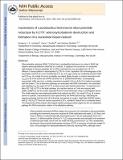Inactivation of Lactobacillus leichmannii ribonucleotide reductase by F2CTP: adenosylcobalamin destruction and formation of a nucleotide based radical
Author(s)
Lohman, Gregory J. S.; Gerfen, Gary J.; Stubbe, JoAnne
DownloadStubbe_Inactivation of.pdf (972.7Kb)
PUBLISHER_POLICY
Publisher Policy
Article is made available in accordance with the publisher's policy and may be subject to US copyright law. Please refer to the publisher's site for terms of use.
Terms of use
Metadata
Show full item recordAbstract
Ribonucleotide reductase (RNR, 76 kDa) from Lactobacillus leichmannii is a class II RNR that requires adenosylcobalamin (AdoCbl) as a cofactor. It catalyzes the conversion of nucleoside triphosphates to deoxynucleotides and is 100% inactivated by 1 equiv of 2′,2′-difluoro-2′-deoxycytidine 5′-triphosphate (F[subscript 2]CTP) in <2 min. Sephadex G-50 chromatography of the inactivation reaction mixture for 2 min revealed that 0.47 equiv of a sugar moiety is covalently bound to RNR and 0.25 equiv of a cobalt(III) corrin is tightly associated, likely through a covalent interaction with C[subscript 419] (Co−S) in the active site of RNR [Lohman, G. J. S., and Stubbe, J. (2010) Biochemistry 49, DOI: 10.1021/bi902132u]. After 1 h, a similar experiment revealed 0.45 equiv of the Co−S adduct associated with the protein. Thus, at least two pathways are associated with RNR inactivation: one associated with alkylation by the sugar of F[subscript 2]CTP and the second with AdoCbl destruction. To determine the fate of [1′-[superscript 3]H]F2CTP in the latter pathway, the reaction mixture at 2 min was reduced with NaBH[subscript 4] (NaB[superscript 2]H[subscript 4]) and the protein separated from the small molecules using a centrifugation device. The small molecules were dephosphorylated and analyzed by HPLC to reveal 0.25 equiv of a stereoisomer of cytidine, characterized by mass spectrometry and NMR spectroscopy, indicating the trapped nucleotide had lost both of its fluorides and gained an oxygen. High-field ENDOR studies with [1′-[superscript 2]H]F[subscript 2]CTP from the reaction quenched at 30 s revealed a radical that is nucleotide-based. The relationship between this radical and the trapped cytidine analogue provides insight into the nonalkylative pathway for RNR inactivation relative to the alkylative pathway.
Date issued
2010-01Department
Massachusetts Institute of Technology. Department of Biology; Massachusetts Institute of Technology. Department of ChemistryJournal
Biochemistry
Publisher
American Chemical Society (ACS)
Citation
Lohman, Gregory J. S., Gary J. Gerfen, and JoAnne Stubbe. “Inactivation of Lactobacillus Leichmannii Ribonucleotide Reductase by 2′,2′-Difluoro-2′-deoxycytidine 5′-Triphosphate: Adenosylcobalamin Destruction and Formation of a Nucleotide-Based Radical.” Biochemistry 49.7 (2010): 1396–1403.
Version: Author's final manuscript
ISSN
0006-2960
1520-4995